Abstract
BACKGROUND--Coronary artery spasm induces activation of the coagulation system. Turnover and maintenance of thrombus depend not only on formation but also on lysis. The relation between coronary spasm and fibrinolytic system has not been elucidated. OBJECTIVE--To examine whether there is impairment of or a circadian variation in fibrinolytic activity in patients with variant angina. METHODS--Plasminogen activator inhibitor (PAI) activity and concentrations of tissue plasminogen activator (t-PA) antigen were measured in venous plasma samples taken at 2200, 0600, and 1400 and 24 h Holter tapes were recorded in 15 patients with variant angina, 12 patients with stable exertional angina, and 12 controls. RESULTS--There were significant circadian variations in PAI activity and t-PA antigen with peak values at 0600 in all three groups. Mean (SEM) PAI activity (IU/ml) at 2200, 0600, and 1400 was 6.1 (1.1), 11.0 (1.3), and 4.4 (0.6) in the variant angina group; 1.8 (0.7), 5.6 (1.1), and 1.2 (0.3) in the stable exertional angina group; and 1.1 (0.5), 4.5 (0.8), and 0.7 (0.3) in the control group. Furthermore, both plasma PAI activity and t-PA antigen concentrations were significantly higher in the variant angina group than in the stable exertional angina group and the control group at each sampling time. CONCLUSIONS--In patients with variant angina there was a circadian variation in fibrinolytic activity, which was lowest in the early morning, and impaired fibrinolytic activity particularly in the early morning, when attacks of angina occur most frequently.
Full text
PDF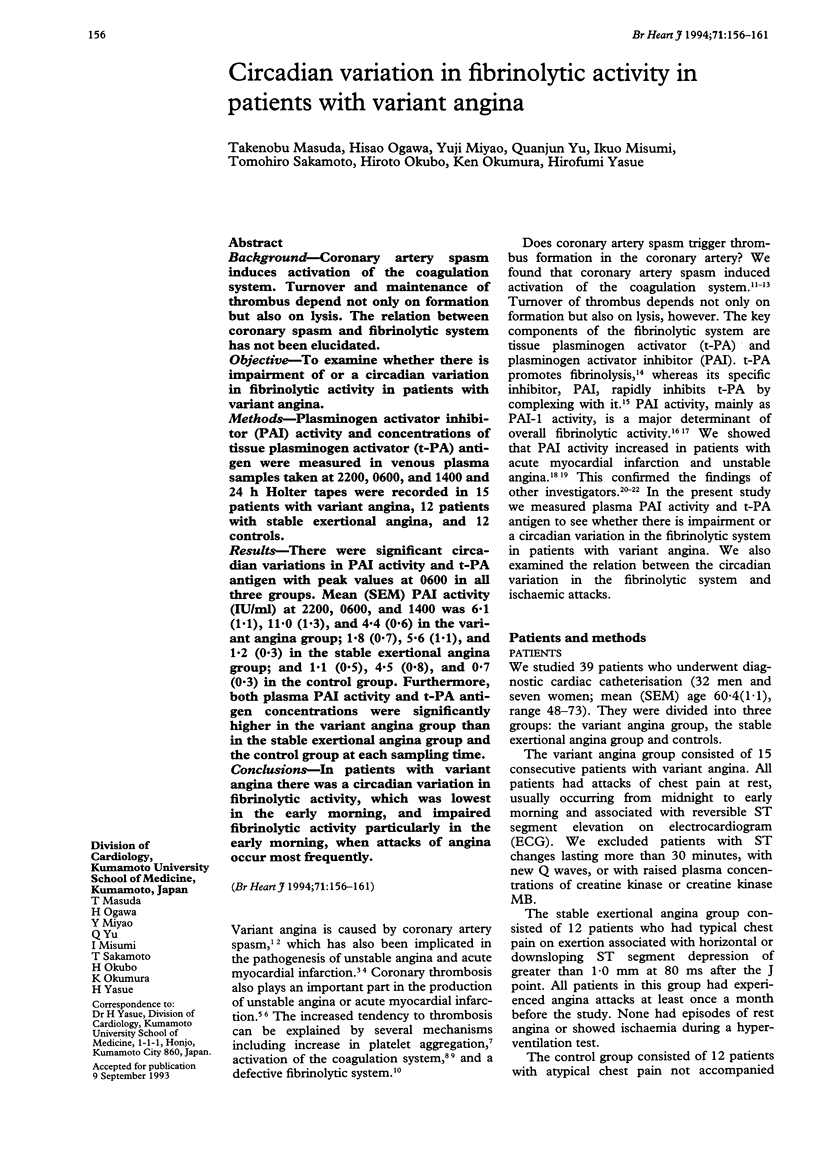
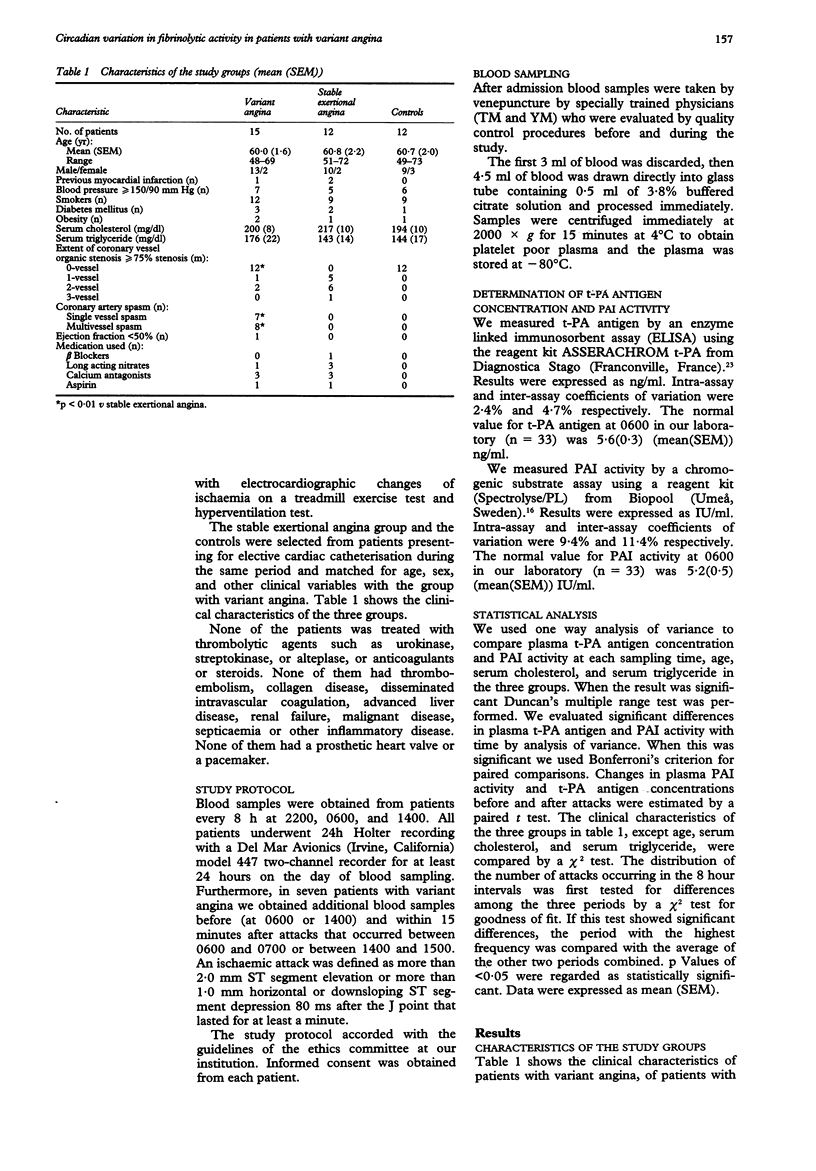
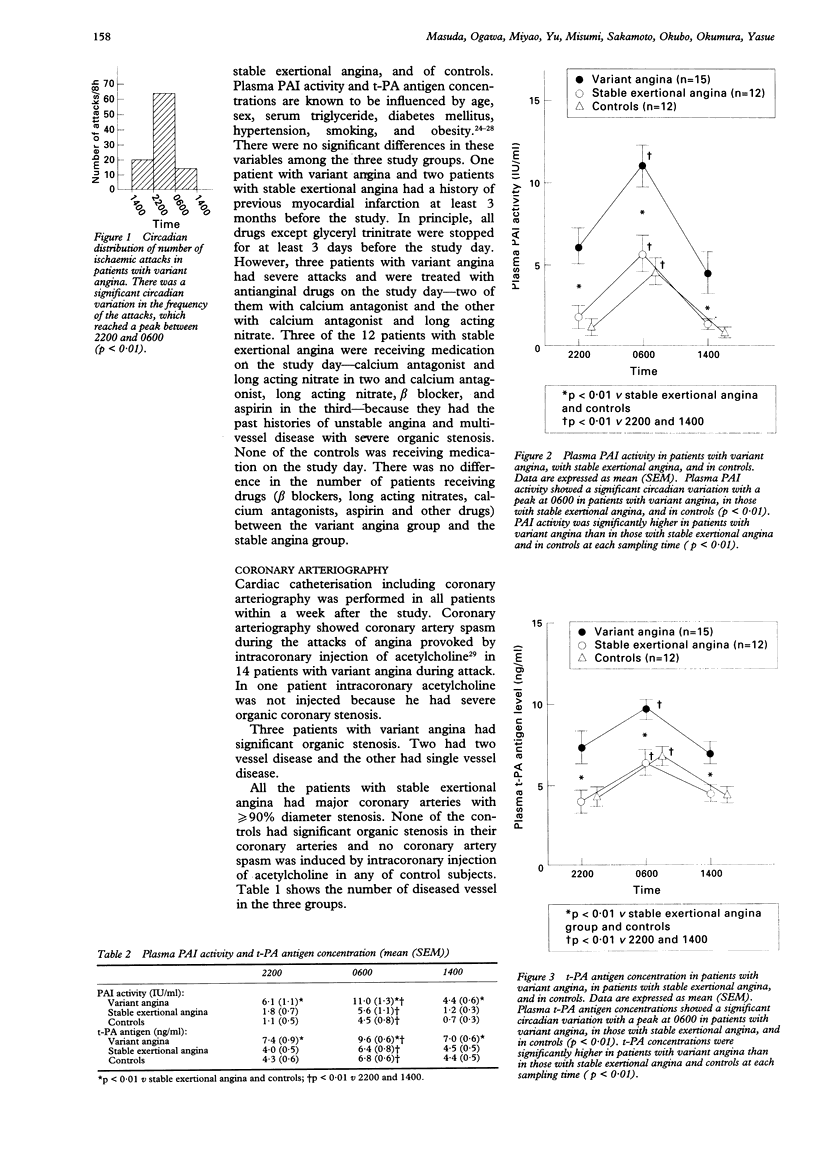
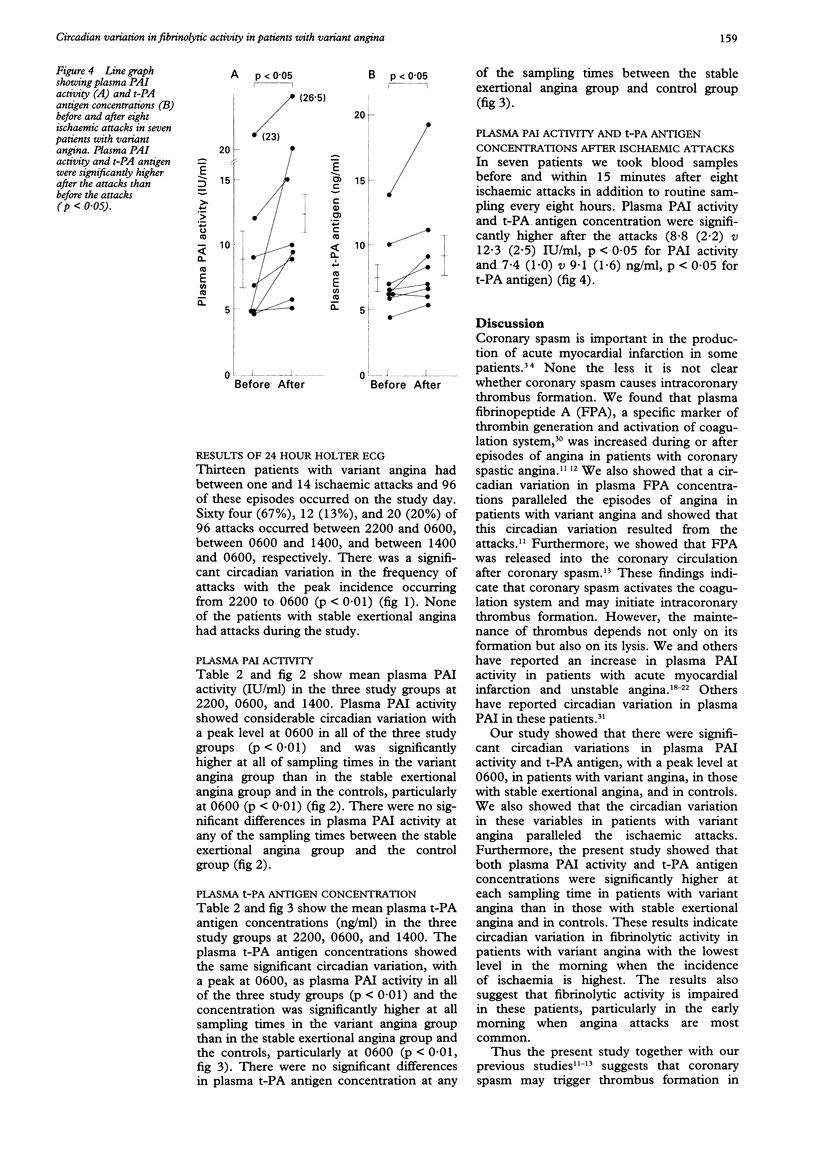

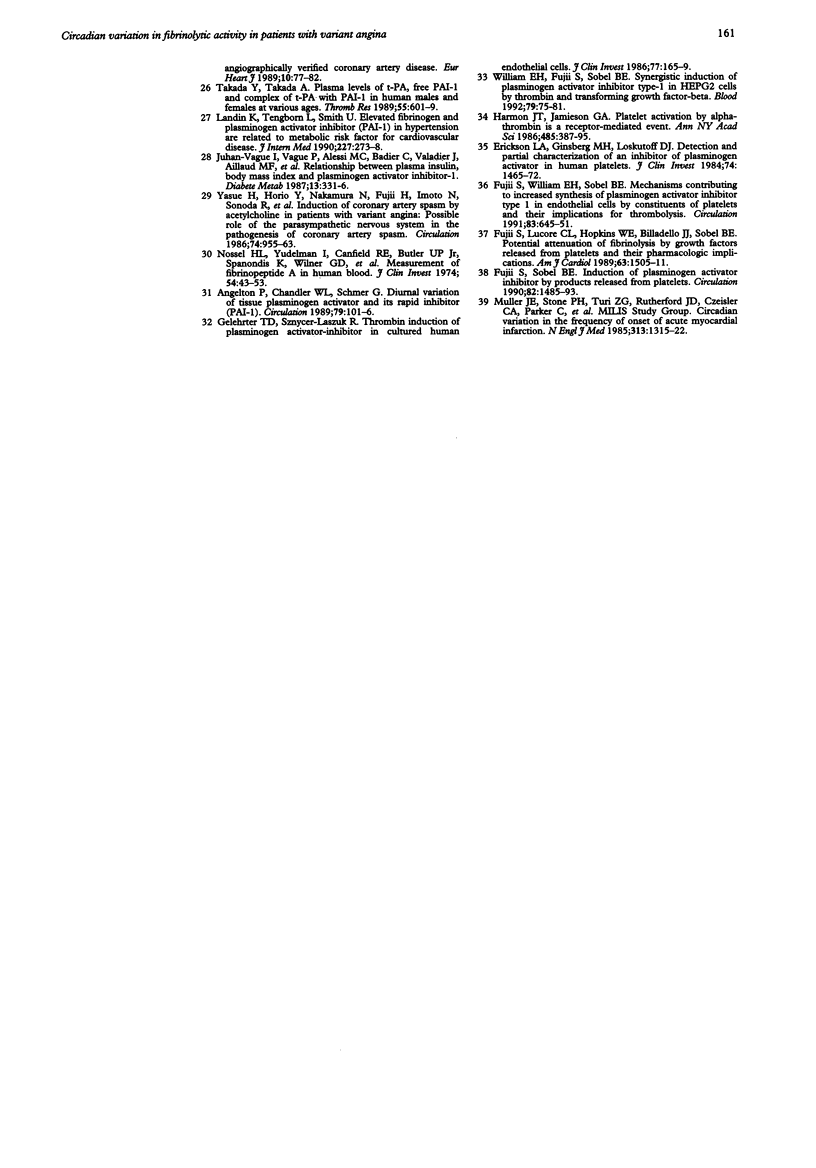
Selected References
These references are in PubMed. This may not be the complete list of references from this article.
- Amiral J., Plassart V., Grosley M., Mimilla F., Contant G., Guyader A. M. Measurement of tPA and tPA-PAI-1 complexes by ELISA, using monoclonal antibodies: clinical relevance. Thromb Res Suppl. 1988;8:99–113. doi: 10.1016/0049-3848(88)90159-4. [DOI] [PubMed] [Google Scholar]
- Angleton P., Chandler W. L., Schmer G. Diurnal variation of tissue-type plasminogen activator and its rapid inhibitor (PAI-1). Circulation. 1989 Jan;79(1):101–106. doi: 10.1161/01.cir.79.1.101. [DOI] [PubMed] [Google Scholar]
- Eisenberg P. R., Sherman L. A., Schectman K., Perez J., Sobel B. E., Jaffe A. S. Fibrinopeptide A: a marker of acute coronary thrombosis. Circulation. 1985 May;71(5):912–918. doi: 10.1161/01.cir.71.5.912. [DOI] [PubMed] [Google Scholar]
- Erickson L. A., Ginsberg M. H., Loskutoff D. J. Detection and partial characterization of an inhibitor of plasminogen activator in human platelets. J Clin Invest. 1984 Oct;74(4):1465–1472. doi: 10.1172/JCI111559. [DOI] [PMC free article] [PubMed] [Google Scholar]
- Eriksson E., Rånby M., Gyzander E., Risberg B. Determination of plasminogen activator inhibitor in plasma using t-PA and a chromogenic single-point poly-D-lysine stimulated assay. Thromb Res. 1988 Apr 1;50(1):91–101. doi: 10.1016/0049-3848(88)90177-6. [DOI] [PubMed] [Google Scholar]
- Fitzgerald D. J., Roy L., Catella F., FitzGerald G. A. Platelet activation in unstable coronary disease. N Engl J Med. 1986 Oct 16;315(16):983–989. doi: 10.1056/NEJM198610163151602. [DOI] [PubMed] [Google Scholar]
- Fujii S., Hopkins W. E., Sobel B. E. Mechanisms contributing to increased synthesis of plasminogen activator inhibitor type 1 in endothelial cells by constituents of platelets and their implications for thrombolysis. Circulation. 1991 Feb;83(2):645–651. doi: 10.1161/01.cir.83.2.645. [DOI] [PubMed] [Google Scholar]
- Fujii S., Lucore C. L., Hopkins W. E., Billadello J. J., Sobel B. E. Potential attenuation of fibrinolysis by growth factors released from platelets and their pharmacologic implications. Am J Cardiol. 1989 Jun 15;63(20):1505–1511. doi: 10.1016/0002-9149(89)90016-7. [DOI] [PubMed] [Google Scholar]
- Fujii S., Sobel B. E. Induction of plasminogen activator inhibitor by products released from platelets. Circulation. 1990 Oct;82(4):1485–1493. doi: 10.1161/01.cir.82.4.1485. [DOI] [PubMed] [Google Scholar]
- Gelehrter T. D., Sznycer-Laszuk R. Thrombin induction of plasminogen activator-inhibitor in cultured human endothelial cells. J Clin Invest. 1986 Jan;77(1):165–169. doi: 10.1172/JCI112271. [DOI] [PMC free article] [PubMed] [Google Scholar]
- Hamsten A., Wiman B., de Faire U., Blombäck M. Increased plasma levels of a rapid inhibitor of tissue plasminogen activator in young survivors of myocardial infarction. N Engl J Med. 1985 Dec 19;313(25):1557–1563. doi: 10.1056/NEJM198512193132501. [DOI] [PubMed] [Google Scholar]
- Harmon J. T., Jamieson G. A. Platelet activation by alpha-thrombin is a receptor-mediated event. Ann N Y Acad Sci. 1986;485:387–395. doi: 10.1111/j.1749-6632.1986.tb34599.x. [DOI] [PubMed] [Google Scholar]
- Hopkins W. E., Fujii S., Sobel B. E. Synergistic induction of plasminogen activator inhibitor type-1 in HEP G2 cells by thrombin and transforming growth factor-beta. Blood. 1992 Jan 1;79(1):75–81. [PubMed] [Google Scholar]
- Juhan-Vague I., Vague P., Alessi M. C., Badier C., Valadier J., Aillaud M. F., Atlan C. Relationships between plasma insulin triglyceride, body mass index, and plasminogen activator inhibitor 1. Diabete Metab. 1987 Jul;13(3 Pt 2):331–336. [PubMed] [Google Scholar]
- Landin K., Tengborn L., Smith U. Elevated fibrinogen and plasminogen activator inhibitor (PAI-1) in hypertension are related to metabolic risk factors for cardiovascular disease. J Intern Med. 1990 Apr;227(4):273–278. doi: 10.1111/j.1365-2796.1990.tb00157.x. [DOI] [PubMed] [Google Scholar]
- Lucore C. L., Sobel B. E. Interactions of tissue-type plasminogen activator with plasma inhibitors and their pharmacologic implications. Circulation. 1988 Mar;77(3):660–669. doi: 10.1161/01.cir.77.3.660. [DOI] [PubMed] [Google Scholar]
- Maseri A., L'Abbate A., Baroldi G., Chierchia S., Marzilli M., Ballestra A. M., Severi S., Parodi O., Biagini A., Distante A. Coronary vasospasm as a possible cause of myocardial infarction. A conclusion derived from the study of "preinfarction" angina. N Engl J Med. 1978 Dec 7;299(23):1271–1277. doi: 10.1056/NEJM197812072992303. [DOI] [PubMed] [Google Scholar]
- Masuda T., Yasue H., Ogawa H., Misumi I., Sakamoto T., Okubo H., Miyao Y., Kato H. Plasma plasminogen activator inhibitor activity and tissue plasminogen activator levels in patients with unstable angina and those with coronary spastic angina. Am Heart J. 1992 Aug;124(2):314–319. doi: 10.1016/0002-8703(92)90592-j. [DOI] [PubMed] [Google Scholar]
- Mehta J., Mehta P., Lawson D., Saldeen T. Plasma tissue plasminogen activator inhibitor levels in coronary artery disease: correlation with age and serum triglyceride concentrations. J Am Coll Cardiol. 1987 Feb;9(2):263–268. doi: 10.1016/s0735-1097(87)80373-x. [DOI] [PubMed] [Google Scholar]
- Muller J. E., Stone P. H., Turi Z. G., Rutherford J. D., Czeisler C. A., Parker C., Poole W. K., Passamani E., Roberts R., Robertson T. Circadian variation in the frequency of onset of acute myocardial infarction. N Engl J Med. 1985 Nov 21;313(21):1315–1322. doi: 10.1056/NEJM198511213132103. [DOI] [PubMed] [Google Scholar]
- Nilsson I. M., Ljungnér H., Tengborn L. Two different mechanisms in patients with venous thrombosis and defective fibrinolysis: low concentration of plasminogen activator or increased concentration of plasminogen activator inhibitor. Br Med J (Clin Res Ed) 1985 May 18;290(6480):1453–1456. doi: 10.1136/bmj.290.6480.1453. [DOI] [PMC free article] [PubMed] [Google Scholar]
- Nossel H. L., Yudelman I., Canfield R. E., Butler V. P., Jr, Spanondis K., Wilner G. D., Qureshi G. D. Measurement of fibrinopeptide A in human blood. J Clin Invest. 1974 Jul;54(1):43–53. doi: 10.1172/JCI107749. [DOI] [PMC free article] [PubMed] [Google Scholar]
- Ogawa H., Yasue H., Oshima S., Okumura K., Matsuyama K., Obata K. Circadian variation of plasma fibrinopeptide A level in patients with variant angina. Circulation. 1989 Dec;80(6):1617–1626. doi: 10.1161/01.cir.80.6.1617. [DOI] [PubMed] [Google Scholar]
- Oliva P. B., Breckinridge J. C. Arteriographic evidence of coronary arterial spasm in acute myocardial infarction. Circulation. 1977 Sep;56(3):366–374. doi: 10.1161/01.cir.56.3.366. [DOI] [PubMed] [Google Scholar]
- Oliva P. B., Potts D. E., Pluss R. G. Coronary arterial spasm in Prinzmetal angina. Documentation by coronary arteriography. N Engl J Med. 1973 Apr 12;288(15):745–751. doi: 10.1056/NEJM197304122881501. [DOI] [PubMed] [Google Scholar]
- Olofsson B. O., Dahlén G., Nilsson T. K. Evidence for increased levels of plasminogen activator inhibitor and tissue plasminogen activator in plasma of patients with angiographically verified coronary artery disease. Eur Heart J. 1989 Jan;10(1):77–82. doi: 10.1093/oxfordjournals.eurheartj.a059384. [DOI] [PubMed] [Google Scholar]
- Oshima S., Ogawa H., Yasue H., Okumura K., Matsuyama K., Miyagi H. Increased plasma fibrinopeptide A levels during attacks induced by hyperventilation in patients with coronary vasospastic angina. J Am Coll Cardiol. 1989 Jul;14(1):150–154. doi: 10.1016/0735-1097(89)90065-x. [DOI] [PubMed] [Google Scholar]
- Oshima S., Yasue H., Ogawa H., Okumura K., Matsuyama K. Fibrinopeptide A is released into the coronary circulation after coronary spasm. Circulation. 1990 Dec;82(6):2222–2225. doi: 10.1161/01.cir.82.6.2222. [DOI] [PubMed] [Google Scholar]
- Roberts W. C., Jones A. A. Quantification of coronary arterial narrowing at necropsy in acute transmural myocardial infarction. Analysis and comparison of findings in 27 patients and 22 controls. Circulation. 1980 Apr;61(4):786–790. doi: 10.1161/01.cir.61.4.786. [DOI] [PubMed] [Google Scholar]
- Sakamoto T., Yasue H., Ogawa H., Misumi I., Masuda T. Association of patency of the infarct-related coronary artery with plasma levels of plasminogen activator inhibitor activity in acute myocardial infarction. Am J Cardiol. 1992 Aug 1;70(3):271–276. doi: 10.1016/0002-9149(92)90603-v. [DOI] [PubMed] [Google Scholar]
- Sherman C. T., Litvack F., Grundfest W., Lee M., Hickey A., Chaux A., Kass R., Blanche C., Matloff J., Morgenstern L. Coronary angioscopy in patients with unstable angina pectoris. N Engl J Med. 1986 Oct 9;315(15):913–919. doi: 10.1056/NEJM198610093151501. [DOI] [PubMed] [Google Scholar]
- Sprengers E. D., Kluft C. Plasminogen activator inhibitors. Blood. 1987 Feb;69(2):381–387. [PubMed] [Google Scholar]
- Takada Y., Takada A. Plasma levels of t-PA free PAI-1 and a complex of t-PA with PAI-1 in human males and females at various ages. Thromb Res. 1989 Sep 1;55(5):601–609. doi: 10.1016/0049-3848(89)90392-7. [DOI] [PubMed] [Google Scholar]
- Théroux P., Latour J. G., Léger-Gauthier C., De Lara J. Fibrinopeptide A and platelet factor levels in unstable angina pectoris. Circulation. 1987 Jan;75(1):156–162. doi: 10.1161/01.cir.75.1.156. [DOI] [PubMed] [Google Scholar]
- Urano T., Sakakibara K., Rydzewski A., Urano S., Takada Y., Takada A. Relationships between euglobulin clot lysis time and the plasma levels of tissue plasminogen activator and plasminogen activator inhibitor 1. Thromb Haemost. 1990 Feb 19;63(1):82–86. [PubMed] [Google Scholar]
- Yasue H., Horio Y., Nakamura N., Fujii H., Imoto N., Sonoda R., Kugiyama K., Obata K., Morikami Y., Kimura T. Induction of coronary artery spasm by acetylcholine in patients with variant angina: possible role of the parasympathetic nervous system in the pathogenesis of coronary artery spasm. Circulation. 1986 Nov;74(5):955–963. doi: 10.1161/01.cir.74.5.955. [DOI] [PubMed] [Google Scholar]
- Yasue H., Touyama M., Kato H., Tanaka S., Akiyama F. Prinzmetal's variant form of angina as a manifestation of alpha-adrenergic receptor-mediated coronary artery spasm: documentation by coronary arteriography. Am Heart J. 1976 Feb;91(2):148–155. doi: 10.1016/s0002-8703(76)80568-6. [DOI] [PubMed] [Google Scholar]
- Zalewski A., Shi Y., Nardone D., Bravette B., Weinstock P., Fischman D., Wilson P., Goldberg S., Levin D. C., Bjornsson T. D. Evidence for reduced fibrinolytic activity in unstable angina at rest. Clinical, biochemical, and angiographic correlates. Circulation. 1991 May;83(5):1685–1691. doi: 10.1161/01.cir.83.5.1685. [DOI] [PubMed] [Google Scholar]
- Zamarron C., Lijnen H. R., Collen D. Kinetics of the activation of plasminogen by natural and recombinant tissue-type plasminogen activator. J Biol Chem. 1984 Feb 25;259(4):2080–2083. [PubMed] [Google Scholar]


